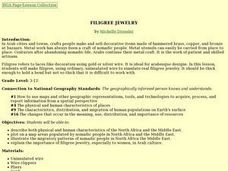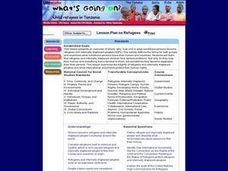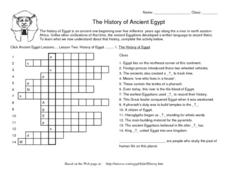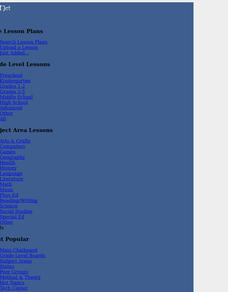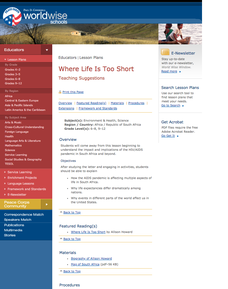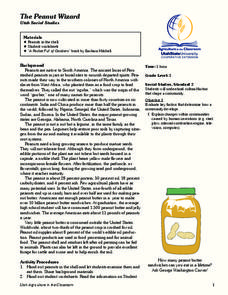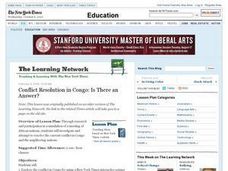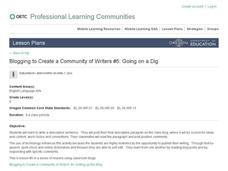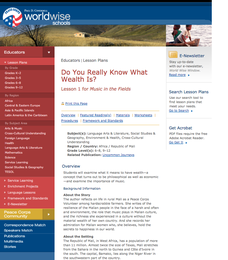Curated OER
Ancient Egypt: Connecting Literature and Geography
Students brainstorm prior knowledge of Ancient Egypt, locate Egypt on map of Africa and on world map, watch King Tut film, discuss term biography, and map geographical information mentioned in stories and documentaries about Ancient Egypt.
Curated OER
Mapping and Personifying Nations
Eleventh graders analyze the geography, actions, and relationships of countries involved in World War II. They create a map of Europe, Northern Africa, and the Pacific, and analyze and evaluate their self-made map of Europe and the...
Curated OER
Brochure of African Countries
Students research a country in Africa and present the information they found and the brochure they designed to the class while their peers take notes to use as a study guide for the exam.
Curated OER
Filigree Jewelry
Students describe physical and human characteristics of North Africa and the Middle East, plot on a map areas populated by nomadic people in those areas, explain importance of filigree jewelry in Arab culture, and create their own jewelry.
Curated OER
Lesson Plan on Refugees
Students explore the issue of "human rights" and discuss world events/situations in which human rights are in question. They determine their own needs and wants and simulate the experience of being a refugee having to leave their home. ...
Curated OER
Seven Wonders of the World: The Great Pyramids
Students explore the Great Pyramids. For this lesson on Egyptian culture, students use primary sources to examine Egyptians. Students will design and draft blue prints of their own pyramid.
Curated OER
On the Road Again
Students examine migration patterns in Africa and China. They watch excerpts from a documentary, define key vocabulary words, complete various student organizers, and create a poster.
Curated OER
The Dawn of Humanity
Students investigate recent archaeological challenges to theories of human origins. They research the history and geography of various African regions to create proposals for future excavations.
Curated OER
Exile: Cuba and the United States
High schoolers gain an understanding of U.S./Cuban Relations. In this world history lesson plan, students examine the events of the Cuban revolution and their effect on U.S.-Cuban relations and U.S. foreign policy.
Curated OER
Building Bridges for Young Learners--Culture
Students explore the concept of "culture." In this cross curriculum literacy and world history instructional activity, students listen to a letter written by a child from Namibia, then compare and contrast life in Africa with their own...
Curated OER
The History of Ancient Egypt
In this World History worksheet, students use the clues to identify what historians now understand about ancient Egypt and its people. They complete each of 14 clues with a word or phrase related to what they already know.
Curated OER
Africa's Climatic Regions
Learners are introduced to the different climates and vegetation of Africa, and compare them to similar climatic regions found in the United States.
Curated OER
History/Geography
Students review North America, Africa, Europe and Asia. They identify Australia as the smallest continent. They identify Australia as an island continent nicknamed "the land down under." They color a map of Australia.
Curated OER
VH1 Goes Inside (Out) Trey and Dave Go to Africa
High schoolers discuss the Western method of teaching and learning music and compare that to the aural transmission method used around the world. They practice singing two songs using aural transmission and watch a video showing...
Curated OER
Where Life Is Too Short
Students study the impact and implications of the HIV/AIDS pandemic in South Africa and beyond. They explain how the AIDS pandemic is affecting multiple aspects of life in South Africa and why life expectancies differ dramatically among...
Curated OER
Letters from the Japanese American Internment
Students examine letters of Japanese-American children during internment in World War II. They discover what it was like in the camps and how they were treated once they were released. They also view photographs of the camps.
Curated OER
The Peanut Wizard
Students investigate the history of the peanut. In this social studies lesson, students read the book A Pocket Full of Goobers and examine the a peanut. Students discuss the peanut's characteristics and take notes on an article about...
Curated OER
Trey and Dave Go to Africa
High schoolers explain the similarity of musical meanings and uses of music globally. They explain the different ways in which music is valued within societies.
Curated OER
Conflict Resolution in Congo: Is There an Answer?
Students research and participate in a simulation of a meeting of African nations. They investigate and attempt to resolve the conflict in Congo and the neighboring nations.
Curated OER
Rites of Passage
Students, through video and Internet activities, are exposed to rites of passage in two modern day West African cultures, the Fulani and the Dogon, and how slavery served as a rite of passage for many West African people in the past.
Curated OER
Blogging To Create A Community of Writers # 5 of 7
Here is lesson 5 from a 7 lesson unit on using blogging to create a community of writers. The aim of this lesson is to get students writing about what Archaeologists do and how they use material data to study the past. They compose a...
Curated OER
My Secret War - The WWII Diary of Madeline Beck: Lesson 2
Fifth graders explore world history by reading historical fiction. In this World War II lesson, 5th graders read the story My Secret War and identify the importance of fiction when analyzing history. Students answer study questions about...
Curated OER
Do You Really Know What Wealth Is?
Young scholars examine what it means to have wealth-a concept that turns out to be philosophical as well as economic-and examine the importance of music. They examine the concepts of wealth in Mali and in the United States and consider...
Curated OER
Communism
Seventh graders study communism. For this world history lesson, 7th graders discuss the similarities and differences between communism and democracies by writing Venn Diagrams.





